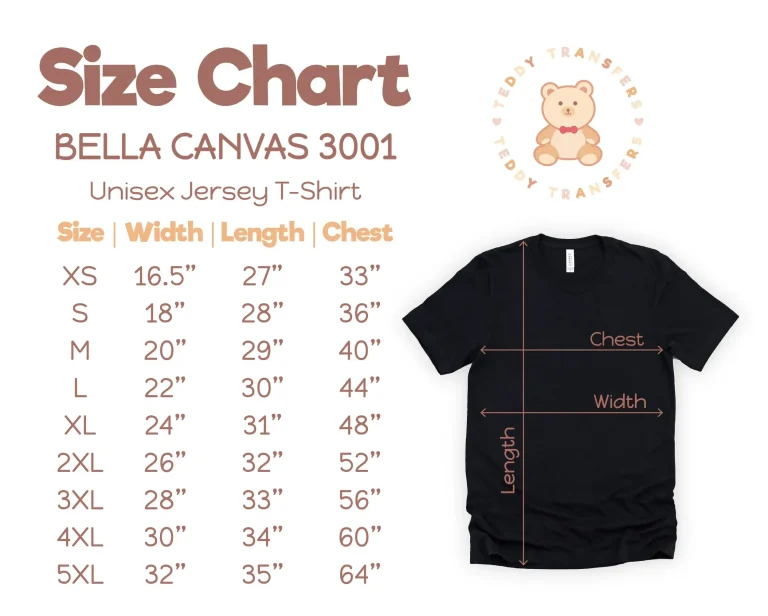When it comes to achieving top-notch results in the world of textile printing, **DTF transfer by size** stands as a critical factor for success. This innovative technique, known as Direct-to-Film transfer printing, allows designers to showcase vibrant colors and intricate details directly onto various garments. However, many enthusiasts often overlook essential aspects such as DTF design sizing, leading to common DTF transfer mistakes that can compromise the final product. By adhering to best practices for DTF transfers, you can ensure that artwork fits correctly and translates into high DTF printing quality. In this article, we’ll guide you through the necessary considerations and tips to optimize sizing for stunning print results.
Direct-to-Film (DTF) printing offers a revolutionary approach for customizing garments, but understanding the implications of size is paramount. Often referred to in the industry as DTF garment transfer sizing, this process emphasizes the importance of scaling designs to match specific apparel dimensions. Many creators encounter pitfalls related to misaligned artwork and unsuitable dimensions, which can lead to unprofessional finishes. By learning about effective DTF design sizing and related techniques, users can enhance their outcomes significantly. This guide will delve into crucial strategies to master size for DTF transfers, ensuring your printed pieces stand out.
Understanding DTF Transfer by Size
When engaging in DTF transfer printing, understanding the nuances of size is paramount. DTF transfer by size primarily dictates how designs are presented on garments. It’s essential to maintain a balance between the artwork and the clothing dimensions to achieve optimal results. If designs are either too large or too small, it may lead to distortions or an unprofessional appearance. This can notably affect the consumer’s perception of value and craftsmanship. Therefore, gaining comprehensive knowledge about sizing standards and garment dimensions can significantly enhance quality.
Furthermore, it’s crucial to consider the context in which the garment will be worn. For instance, a design that looks stunning on a standard t-shirt may lose its appeal when printed on a fitted style. The placement and size of the design must harmonize not only with the garment itself but also with the intended audience. As such, designers need to be proactive about adjusting their graphics to suit different styles and sizes, ensuring that the final product conveys the intended message effectively.
Common DTF Transfer Mistakes to Avoid
Common mistakes in DTF transfer printing can hinder results and affect overall quality. One critical error is failing to size designs correctly relative to garments. Incorrect dimensions lead to products that fail to meet customer expectations, often resulting in unsatisfactory sales. Prior to printing, it’s advisable to measure the printable area of the garment accurately. This precaution ensures each design fits precisely and retains its intended aesthetic. Ignoring these steps can diminish the professional appeal that customers look for in custom apparel.
Another frequent pitfall relates to resolution and color management. Low-resolution graphics can yield prints that appear pixelated or blurry, which diminishes the visual impact of the design. To produce high-quality prints, images should be prepared at a minimum resolution of 300 DPI. Additionally, proper color settings are crucial; artwork should be designed in RGB to ensure colors remain vibrant once transferred onto the fabric. Mismanaging resolution and color can lead to disappointing results that fail to attract repeat business.
Best Practices for DTF Transfers
To achieve remarkable DTF transfer results, adhering to best practices is essential. Conducting thorough tests prior to full-scale production allows for the identification of optimal size and material pairings. Every garment type may react differently to the DTF process, impacting the final appearance. By taking the time to test various artworks on multiple fabrics and sizes, producers can pinpoint the most suitable combinations that yield the best prints. This method not only enhances quality but also minimizes waste.
In addition to testing, maintaining a clean workspace is a vital aspect of successful DTF transfer printing. A clutter-free, sanitary environment helps prevent contaminants from affecting print quality. Regular cleaning schedules for both equipment and workspace ensure the consistency and integrity of transfer results. Alongside cleanliness, it’s important to undertake regular equipment checks to verify printer settings and calibration. These practices can dramatically improve accuracy, leading to professional-grade outputs that satisfy client standards.
Choosing the Right Materials for DTF Transfers
Choosing the appropriate materials is a cornerstone of successful DTF transfers. While many fabrics can be compatible, those made from cotton or cotton blends typically yield superior results. Understanding material properties can also influence the choice of transfer inks and films. By testing designs on various fabric types, print shops can identify the ideal materials that result in efficient transfers that adhere effectively and recreate colors vividly. This early stage of assessing materials significantly enhances performance, ensuring consumer satisfaction.
Moreover, the longevity of the designs is heavily reliant on the fabric chosen. Some synthetic materials may not react favorably to heat applied during the transfering process, resulting in peeling or fading over time. Therefore, before initiating any production runs, it’s important to conduct preliminary tests to assess compatibility and durability. This careful approach not only leads to high-quality output but also reinforces the brand’s reputation for excellence in custom apparel.
Post-Processing Procedures for DTF Transfers
Post-processing is a critical stage in the DTF transfer printing process that is often overlooked. After the transfer is adhered to the garment, allowing the item to cool down before peeling is essential. This step helps to secure the transfer onto the fabric properly, which enhances adherence and reduces the likelihood of future peeling. Ignoring this aspect can directly compromise the durability of the print, leading to unhappy customers and potential return issues.
In addition to cooling, handling the garments properly once the transfers have been applied is vital. It is recommended to avoid stretching or pulling the fabric excessively post-pressing, as this can impact the integrity of the transfer. Emphasizing the significance of careful handling and process awareness can lead to long-lasting, high-quality products that not only meet but exceed customer expectations. Establishing strict post-processing protocols can contribute significantly to the overall success of a DTF printing business.
Frequently Asked Questions
What is DTF transfer by size and why is it important?
DTF transfer by size refers to the process of correctly sizing artwork for Direct-to-Film (DTF) transfers to ensure a perfect fit on garments. Proper sizing is crucial because it helps to avoid misalignment and distortion during printing, leading to professional-looking results that meet customer expectations.
What are common mistakes to avoid when sizing DTF transfers?
Common mistakes in DTF transfer sizing include designing artwork that is either too large or too small for the garment. Failing to account for the printable area can result in unprofessional outcomes. Always check the dimensions and adjust your designs accordingly to ensure that they complement the garment’s shape.
How does artwork resolution affect DTF transfer by size?
Artwork resolution is vital for DTF transfer printing; using low-resolution images can lead to pixelated prints. Always use high-quality images at a minimum of 300 DPI to maintain clarity and detail in your designs. This will enhance the overall appearance, making your DTF transfers stand out.
What are best practices for DTF design sizing?
Best practices for DTF design sizing include conducting thorough testing on various garment sizes, maintaining proper resolution, and confirming the garment’s printable area before finalizing designs. Additionally, ensuring a good fit enhances visual appeal and meets customer expectations effectively.
Why is it important to understand fabric compatibility with DTF transfer by size?
Fabric compatibility is essential for DTF transfers as different materials react differently to heat and ink. Cotton blends are often recommended for optimal results. Understanding which fabrics work best can help avoid issues such as poor adhesion and reduced print quality.
How can I achieve the best results with DTF transfer printing by size?
To achieve the best results with DTF transfer printing by size, always test your designs on the intended garment, maintain cleanliness in your workspace, and regularly check printer settings. Following these tips, along with proper sizing practices, helps secure high-quality, durable prints.
| Key Points | Details |
|---|---|
| Introduction to DTF Transfer Printing | DTF transfer printing is transforming the textile industry with its high-quality results and versatility, particularly favored for t-shirt printing. |
| Understanding DTF Transfer Size | Correct sizing of artwork relative to garments is crucial to avoid misalignment and distortion. |
| Common Mistakes to Avoid | Incorrect Sizing, Inadequate Resolution, Ignoring Color Settings, Poor Material Choices, Improper Transfers, Neglecting Post-Processing |
| Tips for Best Results | Conduct Testing, Maintain Cleanliness, Regular Equipment Checks |
Summary
DTF transfer by size is crucial for achieving professional and appealing results in textile printing. In this method, ensuring that the design fits well with the garment’s dimensions avoids common pitfalls such as distortion or misalignment, which can detract from the final product. By understanding the importance of sizing along with factors such as resolution, color management, and material choice, printers can enhance their outputs significantly. Thus, achieving precise sizing not only fulfills customer expectations but also elevates the overall quality of the designs produced. Investing time to perfect these elements ensures success in the vibrant and competitive field of DTF transfers.


